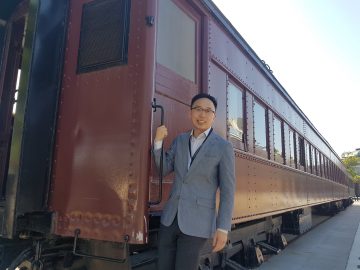We chat with MD/PhD Candidate and current UBCMJ junior managing editor, Daniel Kwon (VMFP Class of 2023), who is studying the use of novel radiopharmaceuticals to target specific elements in cancers for imaging and therapy.

Tell us a little bit about your research project.
The primary focus of my thesis is to develop new radiopharmaceuticals to target specific elements in cancers for imaging and therapy. Nuclear medicine is still a niche field in comparison to fields such as genomics, but it has an important place in current clinical practice, especially in clinical oncology where positron emission tomography (PET) imaging is essential for diagnostic purposes and for monitoring response to chemotherapy. The problem with the widely-used clinical radiopharmaceutical, [18F]fluorodeoxyglucose (FDG), is that while it is generally sensitive, it generally is not specific, leading to a relatively high false positive rate especially in the setting of inflammation or infection. Furthermore, several types of cancers are not imaged well using this radiotracer. My goal is to develop radiopharmaceuticals that will be able to identify specific molecular properties of cancers, while sparing the surrounding healthy tissues and organs to produce a high-contrast PET image identifying cancerous lesions.
What do you find interesting in this field of research? How did you initially get involved?
What drew me to this field was its interdisciplinary nature. Having a background in synthetic organic chemistry in my undergraduate and graduate studies, I was eager to leverage it towards developing molecular therapeutics. Radiopharmaceutical development goes through the same stages as drug development, where a hit is identified, subsequently optimized, and a lead is taken for further preclinical and hopefully clinical testing. Developing radiopharmaceuticals however takes on additional challenges such as having to conjugate a rapidly decaying radioisotope in a short period of time, a challenge that I was eager to face. It is also gratifying to see the direct applications of my work, especially through imaging or treating mouse models of cancers, with the hope of eventually bringing it to the clinic in the future.
What does a typical day look like while working on your project?
It depends on what stage I am at in the project. In the chemical synthesis stage, I am usually in the lab, working with a variety of chemicals and machines to synthesize, purify and characterize candidate molecules with the intention of assaying them for their biological activity and for animal imaging experiments. I will also work with cell lines of various cancers. On the days of the imaging and therapeutic experiments, I am in the animal unit, working with mice. Other days, I am analyzing the results of these experiments and writing the results up for presentations for my supervisor, my research lab and eventually for conference presentations and publications.
What are some of your favourite project-related memories?
I am currently developing radiopharmaceuticals targeting a receptor called C-X-C chemokine receptor 4 (CXCR4). It is expressed in over 20 types of cancers and enables cancers to become aggressive and metastasize. My favourite project-related memory would probably be getting the first imaging results of my first CXCR4-targeting radiotracer that I synthesized independently, which showed the tumor clearly without the rest of the body. This radiotracer still stands as the best one that I have synthesized so far in my doctoral research.
What are some learning opportunities this experience has provided you?
There wasn’t one moment in particular but I think it was gradually understanding how important it is to be organized with respect to both data and people. While writing my first manuscript, I realized that my data was scattered throughout my computers, both at home and at work, and not centralized neatly, making it difficult to make my data presentable. Furthermore, because of how important statistical analysis is, the lack of central data made it much harder to run these analyses in a timely fashion. As such, I have always made sure to centralize my data and make publication-ready figures and tables at the earliest time possible. Finally, because of the multidisciplinary aspect of my work, I rely on other people to collect some data and I quickly learned to ask for data as quickly as possible as it can take a while to obtain sometimes.
What are your research and career aspirations?
Short-term goals include completing and defending my thesis next spring. I am currently writing my thesis and hope to have a first draft in the summer. Afterwards, depending on the COVID19 pandemic, I am hoping to do a few more experiments that will tie together all my chapters in my thesis.
Long-term goals are centered around obtaining an academic appointment as a clinician-scientist somewhere in North America. Currently my plans involve completing a residency in radiology and doing a fellowship in nuclear medicine and a post-doctoral fellowship to strengthen my research plans and to be competitive for the few academic positions with protected research for clinician-scientists.
Photo credits: Alvin Qiu